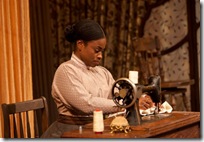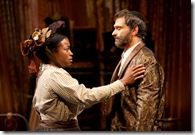However, en route home from last Saturday’s matinee performance, one word ran through my mind, betrayal, for after setting up a lovely, almost idyllic, first act, Nottage pulls out the rug from under both audience and characters to reveal ugly truths about the lies we tell ourselves.
 Facing another year alone in 1905 New York City in a rooming house filled with other single black seamstresses, 35-year-old Esther Mills is flattered to receive a letter from George Armstrong, one of the many black workers building the Panama Canal. Her name, he claims, has been given to him by the son of the deacon of her church down South. Because Esther cannot read or write, she turns to her customers, white unhappy society matron Evangeline Van Buren and beautiful whore Mayme, to pen letters to her long-distance beau. Meanwhile, Esther continues to visit the textile shop run by Mr. Marks, a Hasidic Jew, who sets aside extravagant pieces of cloth especially for his “favorite customer.” That they feel an intimate (but not physical, for that would violate his Orthodox Jewish tenets) is evident in the looks passed between the two or the expressions on each face when the other is not looking. Finally, at the end of the first act, when George comes to New York for their wedding, we want all to be well for this good-hearted, if plain-faced, young woman who has so much to offer a man.
Facing another year alone in 1905 New York City in a rooming house filled with other single black seamstresses, 35-year-old Esther Mills is flattered to receive a letter from George Armstrong, one of the many black workers building the Panama Canal. Her name, he claims, has been given to him by the son of the deacon of her church down South. Because Esther cannot read or write, she turns to her customers, white unhappy society matron Evangeline Van Buren and beautiful whore Mayme, to pen letters to her long-distance beau. Meanwhile, Esther continues to visit the textile shop run by Mr. Marks, a Hasidic Jew, who sets aside extravagant pieces of cloth especially for his “favorite customer.” That they feel an intimate (but not physical, for that would violate his Orthodox Jewish tenets) is evident in the looks passed between the two or the expressions on each face when the other is not looking. Finally, at the end of the first act, when George comes to New York for their wedding, we want all to be well for this good-hearted, if plain-faced, young woman who has so much to offer a man. At this point, I don’t want to give away the rest of the plot so as not to spoil your appreciation for the twists and turns Nottage produces. Suffice it to say that the adage, “Things are seldom what they seem,” plays out here as betrayals abound on all sides, involving friends as well as lovers and spouses. Everyone has been fooled; everyone’s dreams are dashed. And Esther ends as she began.
Director Seret Scott and her production team have provided a jewel box of a set upon which Esther’s story unfolds. Tony Cisek has draped sweeping curtains around the stage which, when lit by different colored lights, take on totally different looks, from Esther’s simple lodgings in Mrs. Dickson’s rooming house to the opulent boudoir of Mrs. Van Buren to the cluttered apartment out of which Mr. Marcus sells his fabrics to the garish room occupied by Mayme the prostitute. Amidst the silks and satins sits Esther’s colorful patchwork quilt, representative of her humble beginnings as a country girl and the place where she hides the money she has saved for her dream of a beauty parlor that caters to black woman. Oliver Gajic’s costumes do a fine job of telegraphing the characters of the persons wearing them. Esther, especially, wears plain browns and grays, indicative of her retiring ways; when she dons her wedding dress, she’s uncomfortable in the luxurious satin and lace. And when Mr. Marcus gives her an elegant length of silk shot through with golden threads to make something for herself, she uses it to sew a smoking jacket for George. Burke Brown’s lighting, while atmospheric, was at times a bit dark, but David Margolin Lawson’s sound design incorporated the whirr of Esther’s sewing machine and the sprightly notes of Ragtime music to give the play a sense of time and place.
Against this lovely backdrop, the splendid actors portray the various characters. Stacy Sergeant is absolutely wonderful as Esther, “plain as butter,” but with a heart as big as all outdoors. She patiently listens to Mrs. Van Buren complain about her affluent life with an inattentive husband, and she never treats Mayme like a whore. She wants things to work out with George so much that we root for their success as husband and wife. When she’s betrayed, we feel betrayed too. But when George reveals his secrets and his feelings of betrayal, we realize that Esther is complicit in her own failure.
As George, Curtis McClarin is at first charming, especially with his soft Barbadian accent; in the second act, despite having to play a cad, he manages to arouse our sympathy for the man who has found something very different from what Esther led him to believe about life in New York. Amy Lynn steward’s Evangeline Van Buren is needy to the point of being tiresome, but her enthusiasm for writing letters for Esther to send to George is infectious. Nikiya Mathis as Mayme is a sad soul, a woman who plays piano well enough to think about becoming a concert pianist but has no way to make a living other than the sex trade. Her betrayal of Esther is especially cruel, since her friend has been nothing but kind to her. Elain Graham’s Mrs. Dickson is a no-nonsense boss, a woman who clearly know what she must do to get ahead in a man’s world, whether it be black or white.
 My favorite character, after Esther, is Mr. Marks. Portrayed as a gentle soul by Matthew Boston (complete with Yiddish-tinged American accent), Mr. Marks recognizes Esther’s worth, but cannot act on it because of social and religious taboos. But he telegraphs his feelings in his eyes, which we can always see even if she cannot, and when she touches him on the chest or shoulders (a religious no-no for him), the act is very intimate and powerful.
My favorite character, after Esther, is Mr. Marks. Portrayed as a gentle soul by Matthew Boston (complete with Yiddish-tinged American accent), Mr. Marks recognizes Esther’s worth, but cannot act on it because of social and religious taboos. But he telegraphs his feelings in his eyes, which we can always see even if she cannot, and when she touches him on the chest or shoulders (a religious no-no for him), the act is very intimate and powerful. Intimate Apparel tells a little known story about black life in New York City at the turn of the twentieth century, but its themes are timeless. People need to look beyond appearances to find the truth about others. What looks too good to be true usually is. In the case of Esther and George, each wanted something so badly that they were willing to deceive to achieve their goal, much to their tragic dismay.
Intimate Apparel will be performed Tuesday, October 5, at 10 AM; Wednesday through Saturday evenings at 8 PM; Wednesday, October 6, at 1 PM (with a post-show event and an audio-described performance for the visually impaired); Saturday, October 9, at 3 PM (a captioned performance for the hearing impaired), and Sunday, October 10, at 3 PM (with a post-show event). “Before Play,” a pre-show conversation starts 45 minutes before curtain time.
The beautiful Two River Theater Playhouse is located at 21 Bridge Avenue in Red Bank. Parking is free near the theater and several nice restaurants are located across the street. For information and tickets, call the box office at 732.345.1400 or visit online at http://www.trtc.org/.